
Gregg Blasdel, view of Eugene Mountains from the entrance of Frank van Zant’s Thunder Mountain Monument. ©SPACES Archives
Photographs taken on site at artist-built environments serve as an indispensable means of experiencing such artworks for most devotees of the genre, as vernacular sites in disparate places are often difficult to visit, change substantially over time, and—in cases where preservation has proven impossible—occasionally disappear altogether.
The Gregg Blasdel collection at SPACES Archives represents one of the most important repositories of documentary material related to vernacular art sites in the United States, with over six thousand images of environments and of the work of self-taught makers more broadly. This collection—the consummation of sixty years of research, relationship building, and road trips by artist and environment advocate Gregg Blasdel—was the focus of my 2023 research fellowship at SPACES. During this valuable time in the archive, I was able to imitate the experience of visiting dozens of sites through sleeve after sleeve of documentary images. Over time, however, I became transfixed by a particular and unexpected kind of documentary image, one which skirts the definition of documentary altogether—those taken near the sites of artist-built environments, but facing away from the artworks themselves and toward the land surrounding them.
In one such image taken outside of Antonito, Colorado (header photo), clouds accumulate along the horizon above the ripple of the Sangre de Cristo mountains near Dominic “Cano” Espinoza’s aluminum-clad residence, which remains beyond the camera’s frame. In the foreground, a blur of dry grass flits past the camera, capturing the movement of Blasdel’s vehicle along the highway. While dozens of other images in the collection capture the complexity of Espinoza’s devotional architecture in all of its breadth and detail, the landscape photograph offers us a moment of meditation upon the Castle’s context within a much broader southwestern ecosystem, as well as Blasdel’s journey in arriving there. Blasdel took a similar photograph at the entrance of Thunder Mountain Monument in Imlay, Nevada (photo above). With Frank van Zant’s complex driftwood, scrap metal, and concrete work looming just a few feet behind him, Blasdel captured the expanse of sand and desert foliage which has returned the gaze of van Zant's environment since it was originally constructed fifty years ago.
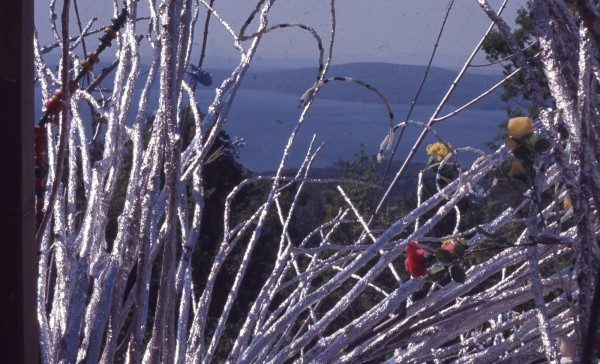
Gregg Blasdel, view of Ashokan Reservoir from Clarence Schmidt’s Silver Forest, c. 1968-1971, Ohayo Mountain, New York. ©SPACES Archives
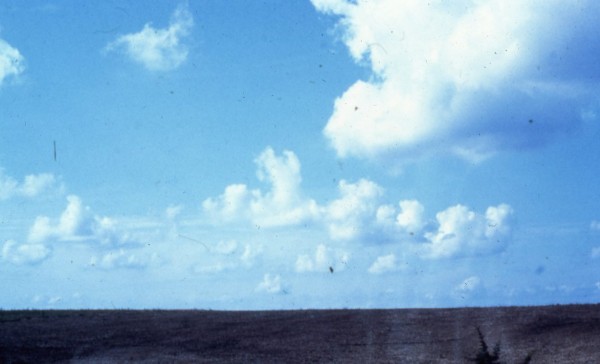
Photographer unknown, view of Garfield Table near the site of Emery Blagdon’s Healing Machine, c. 1980s.
These snapshots of what exists just beyond Espinoza and van Zant’s sites, analogous to many other images taken at environments dispersed throughout the archive, are worth savoring. Though I have spent the last few years as a graduate student reveling in the complex materiality of art environments themselves, the contextual landscape photographs found in Blasdel’s collection served as a generative reminder of the environmental reciprocity which is at the core of many vernacular art sites. Because documenting the environments around artist-built environments is often secondary to the difficult task of capturing the intricacies of a vernacular artist’s work, I have without fail felt a great sense of surprise upon visiting sites for the first time in person, regardless of my knowledge of the route I would take to get there or how many site photographs I had sifted through beforehand. In many images of notable sites that reach publication, the bounds of the artist-built environment are also the bounds of the reproduced image, advertently or inadvertently casting art sites as stand alone, hermetic worlds and their makers as anomalies or isolates. Host towns, surrounding landscape, wildlife, and community members, on the other hand, are made visible only through substantial research.
Experiences with the social and natural ecosystems around artist-built environments, however, are often pivotal to my enjoyment and understanding of such artworks, as I am sure is the case for most site visitors. On my route to Pearl Fryar’s Topiary Garden in South Carolina last spring, the endless walls of pine trees which lined the highways approaching Bishopville were an extended welcome to the pine community that enclosed the southwest perimeter of Fryar's property. The native and introduced plant life at Fryar’s site is not just fodder for the artist’s hedging practice, but a part of the larger habitat which supports substantial bird populations in the area; the sound and constant movement of southern mockingbirds in Fryar’s garden is one of my most vivid memories of the time I spent there. During my stay, Metra Fryar assisted me with identifying a number of plant and animal species in the neighborhood, including a stray cat named Zebra.
Dickeyville Grotto, which similarly seemed to exist at a world removed within many photographs I had seen prior to visiting, is a notable feature within an active and sizable campus of the Holy Ghost Catholic Church near the center of town. In addition to touring the famous grottos and shrines, while in Dickeyville I was able to meet several members of the parish who were knowledgeable of the grottos’ creation and requisite maintenance, attend a yard sale on the church’s property, and tour the newly renovated Holy Ghost cathedral at the encouragement of congregation members—all important to my overall experience with Wernerus’ work and its continued utility. During visits to Q.J. Stephenson’s Occoneechee Trapper’s Lodge in North Carolina and Cecil and Bet Ison’s Home for Wayward Babydolls in Kentucky later this summer, I was invited to visit the art studios of each site steward after touring the environments themselves—both stewards maintained artistic practices beyond the continued maintenance of the respective art environments under their care. These visits too became part of my overall experience of the environment builders’ initial work.
Taking a cue from Blasdel's aforementioned photographic reorientation, we might think about what is gained from momentarily turning our backs to exquisite sites like Cano's Castle, van Zant's Thunder Mountain Monument, or Clarence Schmidt’s My Mirrored Hope (above), and considering the natural, material, and social worlds which churn around them. It is the case for all artist-built environments that external forces—turbulent weather, the local economy of supplies, support and protest of surrounding neighbors—have a notable impact on the aesthetics, common interpretation, and longevity of sites. Additionally, influence is not one directional—the existence of artist-built sites within communities rural and urban alike inevitably alters the surrounding area. In Highwood, Illinois, the former neighborhood of cathedral birdhouse sculptor Aldobrando Piacenza, intricate birdhouses created by a number of makers can be found in front yards for blocks surrounding Piacenza's former property despite the artist’s passing in 1976 and the subsequent dismantling of his art environment (below). On Pearl Fryar’s street, multiple neighbors have similarly adopted impressive topiary practices of their own. While visiting, I had the pleasure of speaking at length with Fryar's longtime neighbor Sammie Sherod, who has practiced topiary for decades and offered me a “smell tour” of his garden. Sherod noted that unlike Fryar’s topiary work, which leans into abstraction, he was inspired by the complex and orderly aesthetics of early modern French garden topiary [below]. On the other side of the United States, evidence of Sabato Rodia's impact can be seen in the many residential entryways encrusted with mosaic, crafted by neighbors of the Towers in Watts, Los Angeles.
Birdhouses in Highwood, Illinois near the former home of Aldobrando Piacenza (photograph taken by author February 2021)
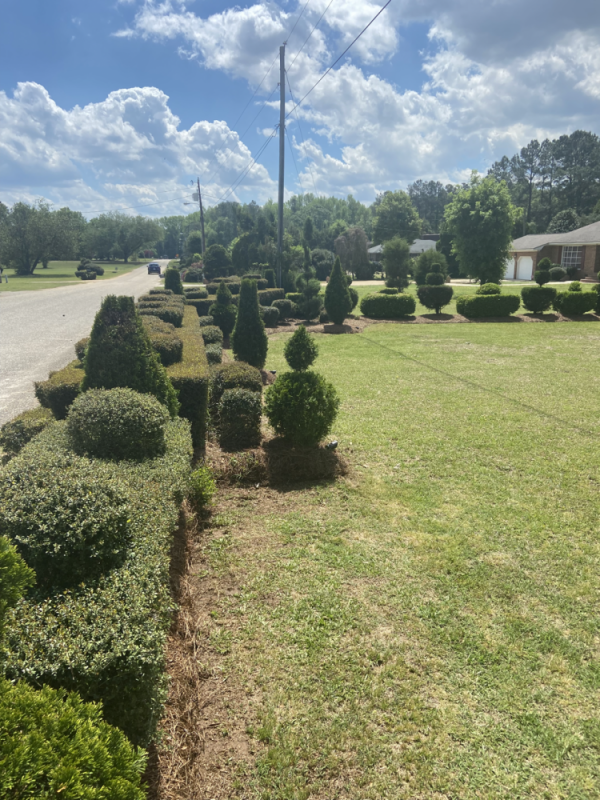
Front yard of Sammie Sherod, Bishopville, South Carolina (photograph taken by author in April 2023)
Beyond artistic influence, sites in vernacular places enjoy all of the risks and privileges of permeability with their surroundings, including the effects of eroding landscapes, city development whims, nesting wildlife, angry neighbors, gifts from visitors, local press attention, preservation volunteerism, surveillance and affection from admirers, and so on. In every case, the potential for creative reciprocity between artist-built sites and their local contexts is one of the most unique and inherently valuable facets of these works. Sites activated by their respective communities become places of shared history and gathering for locals, visitors, and mockingbirds alike. These reverberations on the surrounding landscape ensure that, regardless of the natural cycles of change and death which seem unavoidable to the stories of vernacular art environments, the creative inheritance of these artworks continues to propagate within the ecosystems around them.
A sincere thank you to SPACES Archives and to Gregg Blasdel—whom I have been honored to be in correspondence with this year—for the opportunity to look at and away from artist-built environments together.
Gabrielle Christiansen is a PhD student in the Art History department of Northwestern University specializing in artist-built environments and vernacular artworks of the 20th century United States. She is particularly interested in the ecology of salvaged materials taken up by artists in the creation of built-environments. She was the summer 2023 SPACES Research Fellow.
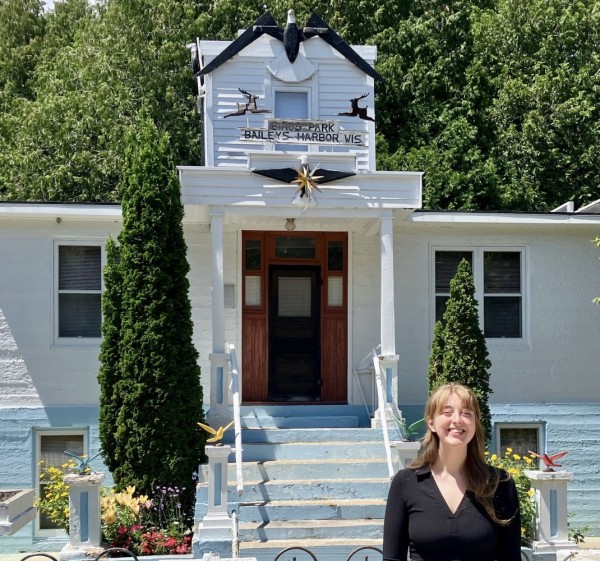
Gabrielle in front of the Albert Zahn house in Bailey's Harbor
Header photo: Gregg Blasdel, view of landscape outside of Antonito, Colorado near Dominic “Cano” Espinoza’s Castle, c. late 2000s. ©SPACES Archives
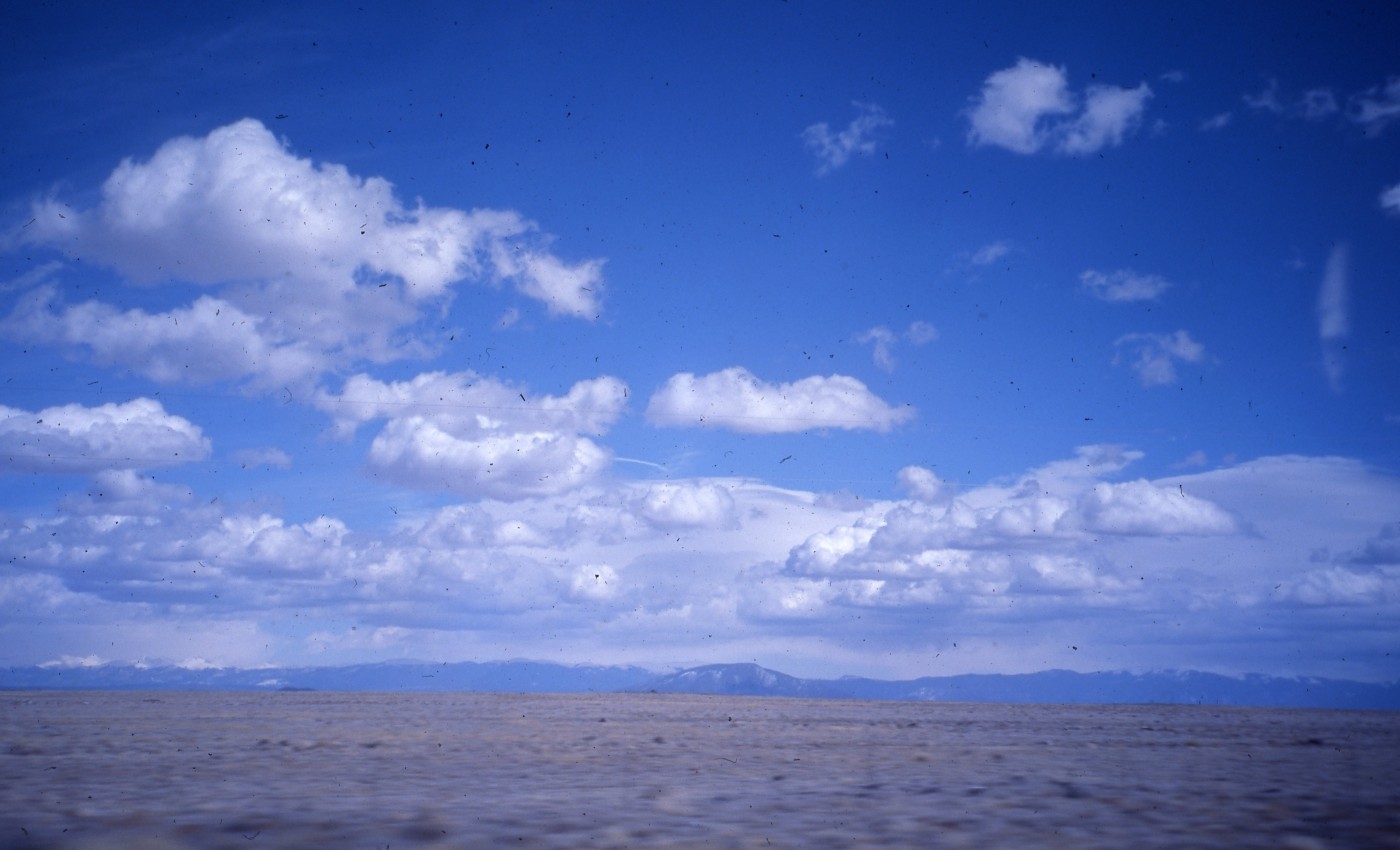

Post your comment
Comments
No one has commented on this page yet.